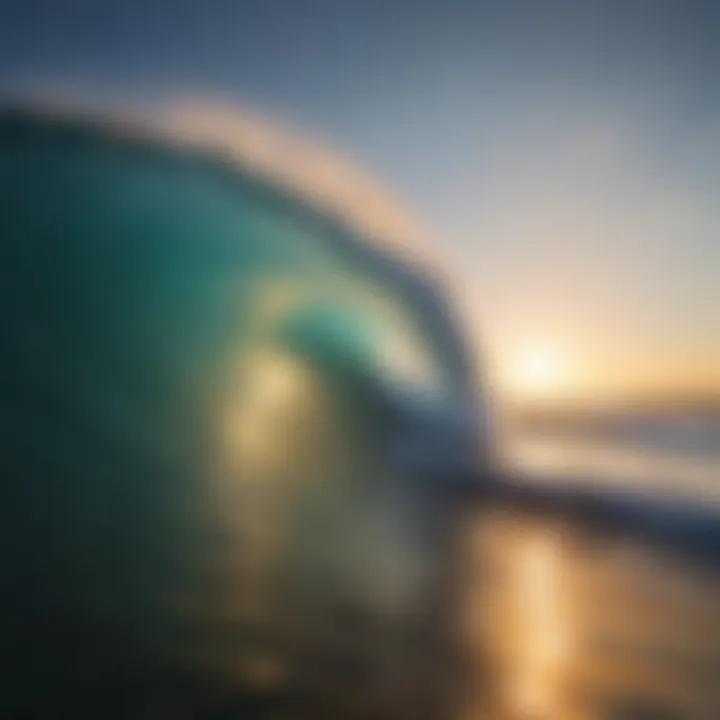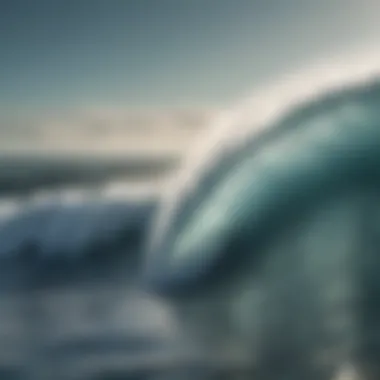Mastering Meteorology for Surfing Enthusiasts


Intro
In the realm of surfing, understanding the weather isn't just a casual bit of knowledge; it's akin to a sailor comprehending the tides. For surfers, meteorology can make or break a day on the waves. Many enthusiasts may catch themselves peering at their phone's weather app, hoping for that glorious forecast that translates into great swell and perfect conditions. But what's really happening behind those numbers and graphics? This article aims to peel back the layers of atmospheric science and its crucial connection to surf conditions, providing surfers with nuanced insights that could enhance their time on the board.
The conversation around surf conditions is a blend of natural science and practical application. This guide starts by laying down the foundational surfboarding techniques. Whether you're a novice working on your paddling or an advanced surfer looking to perfect that maneuver, having solid techniques is essential. This leads us to dive deeper into the equipment used in this beloved sport, exploring reviews of the latest surfboards and gear that every surfer should consider. Through dedicating ourselves to comprehending meteorology, we can navigate our surf sessions more intelligently than before.
Preamble to Meteorology
The world of meteorology is not just about predicting rain or shine; it's a scientific dance with nature that surfers and anyone who enjoys the great outdoors should pay close attention to. Understanding meteorology is crucial for anyone who rides waves, as it provides insights into how various weather patterns influence ocean conditions. This section serves as a stepping stone into the broader themes presented in the article, offering a solid foundation that enhances our knowledge of the changing skies.
Defining Meteorology
At its core, meteorology is the study of the atmosphere, encompassing everything from temperature and pressure to wind patterns and humidity levels. You could say it's like reading the sky's diary—every shift, every cloud that passes, narrates a tale of what’s happening above us. Meteorology doesn’t just stop at forecasting; it integrates sciences like physics, chemistry, and even computer science to create models that help us understand our climate. The intricacies of this field are vast, ranging from daily weather predictions to understanding climate change over decades.
The Importance of Weather in Surfing
For surfers, the weather isn't just a background detail; it’s the main event. Weather conditions determine the quality of the surf, influencing wave size and shape, wind direction, and even safety when hitting the water.
One key element is the wind. North winds tend to create clean, ridable waves, while onshore winds can turn a beautiful day into a choppy mess. The tides also play an important part, influenced by lunar cycles and atmospheric pressure.
Here are a few considerations for surfers to keep in mind:
- Wave Heights: Higher swells are more likely during storms or specific wind conditions, so knowing how to read a surf report is vital.
- Tide Charts: Depending on your location, tides can either enhance or detract from wave quality. It’s essential to understand how this interacts with local geography.
- Safety First: Severe weather systems such as hurricanes don’t just create big waves; they can also result in hazardous surf conditions, making safety awareness critical.
"The ocean is a living entity that reacts to atmospheric changes, almost like a surfer pays attention to the rhythm of the waves. Understanding this interplay can revolutionize the way you experience surfing."
Engaging with meteorology grants surfers the power to plan their sessions more effectively, ensuring they make the most of their time on the water. By grasping basic meteorological concepts, surfers can remain ahead of the game, choosing the optimal times and spots to ride those perfect waves.
Fundamental Concepts of Weather
Understanding the fundamental concepts of weather is crucial for any surfboarding enthusiast. With meteorology being the science that investigates atmospheric phenomena, it serves to inform surfers about conditions that can dramatically affect their time on the waves. Whether it’s predicting the best time to catch a surf session or understanding potential hazards, a solid grasp of these basics can lead to smarter decisions in the water. Let’s dive deeper into the basic building blocks of weather, starting with atmospheric layers and their respective functions.
Atmospheric Layers and Their Functions
The atmosphere is made up of several layers, each serving unique purposes that ultimately influence weather patterns observed at the surface. In simple terms, these layers can be categorized as follows:
- Troposphere: This is the layer closest to the Earth’s surface, where nearly all weather events occur. It hosts clouds, rain, and wind. For surfers, understanding the conditions in this layer helps in predicting how storms might impact sea conditions.
- Stratosphere: Positioned above the troposphere, this layer contains the ozone layer, which absorbs harmful ultraviolet radiation from the sun. The stability of the stratosphere can impact the weather in the troposphere, including wind patterns that may play a role in ocean conditions.
- Mesosphere: The third layer of the atmosphere, where temperatures begin to decrease with altitude. Meteorologically, it’s not as significant for immediate weather conditions, but it contributes to atmospheric dynamics.
- Thermosphere: This layer has very thin air and can reach high temperatures. Though it primarily affects satellite communication and space weather, its interaction with the lower layers can have cascading effects on weather patterns.
- Exosphere: The outermost layer where atmospheric particles are so far apart that they can travel hundreds of kilometers without colliding. This layer is less relevant to surfers but is part of the overall atmospheric framework that influences weather.
By understanding how these layers work, surfers can better appreciate how storms develop, how air pressure fluctuates, and the overall behavior of local weather systems.
Key Meteorological Terms
To navigate through the information available on weather conditions, surfers should familiarize themselves with essential meteorological terms. Knowing these terms can empower surfers to decode weather forecasts and scientific discussions effectively. Here’s a quick list of key terms:
- Cumulus Clouds: Fluffy, white clouds often seen on sunny days. They indicate good weather but can develop into storm clouds.
- Barometric Pressure: This is the weight of the air above a point, influencing winds and temperature. Understanding pressure changes is vital for forecasting.
- Humidity: Refers to the amount of moisture in the air. High humidity can lead to storms, while low humidity may signify clear skies.
- Isobars: Lines on a weather map connecting points of equal pressure. Tight lines indicate strong winds, critical for assessing surfing conditions.
- Cold Front: A boundary where a cold air mass replaces a warm air mass. This is important for surfers to interpret, as cold fronts can lead to sudden weather changes and potential surf opportunities.
"Knowledge of meteorological terms can make the difference between a glorious day at the beach and a regrettable encounter with unexpected weather."
Becoming familiar with these terms not only enhances comprehension but also facilitates safer and more enjoyable surfing experiences by informing decision-making in relation to surf conditions. In understanding atmospheric layers and essential terms, surfers lay down a solid foundation for interpreting the complex realm of meteorology, better equipping themselves for the challenges and rewards of their passion.
Principal Weather Patterns
Understanding principal weather patterns is crucial for anyone looking to enhance their surfing experience. These patterns will not only dictate wave height and frequency but also play a significant role in determining water conditions, tides, and ultimately, the safety of surfers in the water. Knowing how to interpret these weather phenomena can provide surfers the edge they need to make informed decisions, ensuring that their time spent in the water is both productive and enjoyable.
High and Low Pressure Systems
High and low pressure systems are often thw beating heart of weather dynamics. Think of high pressure as an old friend that brings calm, sunny days—generally leading to fair weather. These systems form when air cools and sinks, creating a stable atmosphere. For surfers, this means cleaner waves and less choppy waters.
Conversely, low pressure systems tend to stir the pot—bringing about cloudiness, precipitation, and unpredictable winds. They arise when warm air rises, leading to a less stable atmosphere that can create turbulent sea conditions. This characteristic might be a surfer's worst nightmare. When low pressure is looming over the horizon, it's wise for surfers to keep an eye out for changes in conditions and exercise caution,
Here are some key points to consider when dealing with pressure systems:


- High Pressure:
- Low Pressure:
- Typically yields clearer skies.
- Leads to more consistent wave conditions.
- Winds can be lighter, making paddle-out easier.
- Often brings strong winds and challenging surf.
- Can create swells that are both exciting and hazardous.
- Weather can change quickly, presenting safety risks.
This understanding can be a gamechanger for surfers navigating fickle weather conditions.
Fronts and Their Role in Weather Changes
Fronts represent the boundaries between different air masses and are instrumental in driving short-term weather changes. They exist when a mass of cold air meets warm air, leading to what meteorologists call frontal systems. As a surfer, recognizing these fronts is crucial because they significantly impact wave quality and ocean behavior.
There are generally three types of fronts:
- Cold Fronts: These form when cold air pushes into warmer air. They can create brief but intense storms, resulting in choppy waves and strong currents. Surfers may find that the conditions become unpredictably wild; it's essential to be wary and stay alert.
- Warm Fronts: Opposite to cold fronts, warm air slides over a mass of cooler air. Although these fronts don't usually produce stormy weather, they can lead to cloudy skies and prolonged rain, which can affect surf quality. They may result in slower waves, but sometimes bring welcome swells as they push the warm air.
- Stationary Fronts: These occur when neither air mass is dominant, creating a prolonged period of unstable weather. Surfers might hope for stalled stationary fronts to either clear out or become active, as this could mean varying surf conditions.
"Fronts can be fickle organizations; while they can create inviting surf, they come with challenges that require keen awareness of changing conditions."
Understanding how to read weather fronts allows surfers to plan their sessions effectively. By tapping into this knowledge, they can better anticipate not just the surf quality but also the safety conditions of their local waters.
From the moment one grabs their board, recognizing how these weather patterns work can turn an ordinary surf session into an unforgettable adventure.
Prologue to Oceanography
Oceanography plays a pivotal role in understanding how the vast blue sea interacts with various weather phenomena. For surfers, appreciating this relationship can be a game changer when it comes to predicting surf conditions. Understanding oceanography is not just about appreciating the beauty of waves; it's about being smart on the water and riding the best ones possible. By diving into the nuances of this field, surfers can unlock insights that can enhance their experience and maximize the beauty of nature’s playground.
The Relationship Between Ocean and Weather
The ocean is often referred to as the "heart of weather" because it influences atmospheric conditions on a grand scale. The interplay between sea and atmosphere leads to the formation of weather patterns that surfers must be attuned to.
- Heat Transfer: Oceans absorb a significant amount of solar energy, leading to uneven heating of the water and, consequently, the atmosphere above. This process sparks the formation of various weather systems, from gentle sea breezes to robust storms.
- Evaporation and Humidity: Warm ocean water sends moisture into the air, raising humidity levels. When this humid air moves inland, it can contribute to rainfall, thunderstorms, or even cyclones, all crucial factors to consider for surf conditions.
- Wind Patterns: The ocean surface and the winds form a complex relationship; winds blowing across the surface不仅 affect wave formation but also contribute to the larger weather patterns like El Niño or La Niña. These phenomena can dramatically alter surf conditions across vast coastal swathes, sometimes giving way to exceptional surf days.
"The ocean and the atmosphere are like dance partners – they influence each other's moves, creating rhythms that shape our surf experiences."
Ocean Currents and Their Impact on Surf Conditions
Ocean currents are often deemed the highways of the marine world, carrying warm and cold water across temperatures, and, as a result, influencing weather and surf conditions.
- Types of Currents: Understanding the difference between surface currents (like the Gulf Stream) and deep water currents is essential. While surface currents involve interactions with wind and weather, deep-water currents maintain the ocean's heat and nutrient distributions crucial for marine life.
- Wave Creation: As currents traverse coastlines, they interact with the sea floor, creating distinctive wave patterns. These patterns affect everything from the size of waves to their shape, and ultimately the surf experience.
- Temperature Changes: The warmer waters brought by certain currents can lead to increased storm activity, which can generate larger swells and better surf days. Conversely, colder currents can lead to calmer conditions.
With these aspects in mind, surfers can better understand how oceanography shapes surf conditions, allowing them to make informed decisions about when and where to surf.
In summary, the intricate relationship between oceanography and weather extends far beyond theoretical discussions; it is a framework for understanding real-world surf conditions. Armed with this knowledge, surfers have a roadmap to navigate an often unpredictable landscape.
Meteorological Tools and Techniques
Understanding meteorological tools and techniques is pivotal for surfers looking to harness the unpredictable nature of the ocean. With an array of instruments and methodologies at their disposal, surfers can glean crucial insights into weather conditions, allowing them to time their sessions to perfection and enhance their overall surfing experience. This knowledge not only promotes safety but also heightens the enjoyment that comes with being in sync with the elements.
Weather Instruments: An Overview
A diverse set of instruments is employed in meteorology to monitor various atmospheric conditions. Each of these tools plays a unique role in interpreting the weather's influence on surfing. Here are some significant instruments:
- Anemometers: These devices measure wind speed. For surfers, understanding wind conditions can determine whether waves will be rideable or if conditions are too breezy.
- Barometers: Barometers gauge atmospheric pressure, an essential factor that influences weather patterns. A dropping barometer often indicates the approach of a storm, giving surfers a heads-up to either prepare or steer clear.
- Thermometers: By measuring air and sea temperatures, thermometers can assist surfers in predicting water conditions. It’s well-known that warmer waters can result in different wave characteristics.
- Rain Gauges: These tools measure precipitation, helpful in understanding surf conditions after a rain event. Heavy rain can lead to poor water quality.
- Radar and Satellites: Modern technology has given rise to advanced radar systems and satellites, providing comprehensive weather imagery and analysis. This data helps forecast significant weather systems like tropical storms that surfers must heed for safety.
These tools, when understood and utilized effectively, not only lead to a more enjoyable surf experience but also ensure that safety remains a top priority.
Interpreting Weather Maps
Weather maps serve as a snapshot of atmospheric conditions over a region and are vital for surfers keen on making informed decisions. These maps can appear complex, but breaking them down can be extremely illuminating. Here are the vital elements to look for:
- Isobars: Lines that connect points of equal pressure; their closeness indicates wind speed. Tighter isobars mean stronger winds, which can create choppier surf conditions.
- Fronts: These lines represent the boundary between different air masses. Cold fronts can lead to stormy conditions while warm fronts may bring calmer weather, affecting wave formation.
- Contours and Temperatures: Warm and cold fronts can be understood through temperature symbols. Knowing where warm waters lie helps in selecting the best surf spots.
- Precipitation Indicators: Symbols for rain or snow can inform surfers about current or incoming weather, providing cues about water quality and surf safety.


A well-interpreted weather map can enhance one’s surfing prowess. It’s about reading the signs and realizing what the ocean may bring on any given day.
In summary, meteorological tools and techniques serve as the gatekeepers to a successful surf outing. By honing in on the right instruments and mastering the art of weather map interpretation, surfers can ride the waves with confidence and knowledge, ensuring not just thrills but also safety on the water.
Weather Forecasting
Weather forecasting is a critical aspect of meteorology, especially for surf enthusiasts who rely on it to optimize their time on the waves. By understanding how weather patterns work, surfers can make informed decisions about when and where to catch the best surf. It’s about not just knowing if it’s sunny or raining, but getting a grasp on how those variations can create the conditions surfers crave. Accurate forecasts can enhance a surfer’s experience by aligning their sessions with optimal surf conditions and ensuring safety in unpredictable weather.
Understanding Forecast Models
Forecast models are essentially complex mathematical equations that simulate the atmosphere. They take into account various data from weather stations, satellites, and buoys to produce predictions about future weather phenomena. By analyzing temperature, humidity, wind speed, and direction, these models provide insights on how conditions may evolve.
There are a few primary types of forecast models:
- Numerical Weather Prediction (NWP): This uses mathematical formulas to predict future weather based on current atmospheric conditions. It’s valuable for short-term forecasts.
- Statistical Models: They analyze historical data to predict future patterns. While they may not account for every variable, they can be useful when combined with NWP models.
The reliability of these models depends largely on the quality of the input data. Factors such as ocean temperature and atmospheric pressure systems have to be monitored constantly to ensure accuracy.
Despite advances in technology, no model is foolproof. Understanding their limitations is equally important for surfers.
Limitations of Weather Predictions
While tools and models have improved leaps and bounds, they aren’t beyond reach of the unpredictable nature of weather. Several factors come into play:
- Data Gaps: Not every region has equal access to data sources. Some remote areas may not be covered well, leading to less reliable forecasts.
- Rapidly Changing Conditions: Weather can shift quickly. A forecast made days in advance might not account for sudden changes in conditions like a cold front or unexpected storm systems.
- Local Variability: Coastal areas often experience microclimates. What’s happening a few miles inland may not reflect the conditions near the shore. Factors like geography and local wind patterns can drastically alter weather conditions just a stone’s throw away.
"Even with the best forecasts, the ocean can behave unpredictably. Always keep an eye on updates and don’t just rely on one source of information."
Understanding these limitations helps surfers stay vigilant and adapt to changing conditions, keeping them safe while maximizing their wave-riding experience. By combining forecasting knowledge with practical observation, surfers can better navigate the relationship between weather and surf, leading to more gratifying experiences on the water.
The Impact of Extreme Weather on Surfing
Understanding how extreme weather influences surfing is crucial for both safety and optimizing wave conditions. Surfers must grasp the nuances of these weather phenomena, especially those that can enhance or endanger their experiences in the water. Whether it's big swells generated by distant storms or shifts in wind patterns due to seasonal changes, the dynamics of wind and water can dramatically alter the surf landscape.
Hurricanes and Coastal Conditions
Hurricanes represent one of the most extreme weather conditions that impact coastal areas and, in turn, surfing spots. While most view hurricanes with apprehension, seasoned surfers know that these massive storms can produce exceptional surf conditions. As a hurricane approaches — or even when it’s at a distance — it can create powerful swells that attract surfers looking for the adrenaline rush of riding enormous waves.
One must consider the following impacts:
- Wave Height and Energy: As hurricanes pass through the ocean, they displace vast amounts of water, generating waves that can exceed 20 feet in height. This significant increase in energy can offer thrilling but daunting conditions.
- Changes in Currents: The act of the hurricane churning the ocean can alter currents significantly. For instance, rip currents may become stronger or more unpredictable, posing a risk to even experienced surfers.
- Coastal Erosion: The force of hurricane-driven waves can lead to increased erosion along the coast, which may change the landscape of familiar surf spots.
Surfers looking to ride these colossal waves should always be aware of local advisories and be prepared for rapidly changing conditions. The interplay of atmospheric pressure, wind speed, and ocean temperature leading up to a hurricane can drastically alter surf conditions. Thus, understanding these elements is paramount for any surfing enthusiast.
Assessing Safety Risks for Surfers
With great waves come great responsibility. While the allure of perfect sets during extreme weather can be enticing, safety should never take a backseat. It's essential to assess various risks when deciding to surf during such conditions.
- Lifeguard Presence: During severe weather, lifeguard services might be limited. Knowing this can inform whether it’s wise to hit the waves or stay on solid ground.
- Local Hazards: Often, extreme weather can reveal hidden hazards such as submerged rocks or debris in the water. Conducting a reconnaissance can help detect dangers that aren't usually visible in calmer conditions.
- Experience Levels: Not every surfer is equipped to tackle monster waves. Assessing one’s skill level honestly is critical. Getting caught in a challenging situation can escalate quickly.
- Communication: Always inform others about surf plans, especially during extreme weather. Having someone aware of your location and intentions can make a significant difference in case things go sideways.
"Taking the time to evaluate risks before entering the water is not just wise; it's essential for survival."
Surfers must strike a balance between seeking exhilarating conditions and ensuring their safety. The thrill of extreme weather surfing can be unmatched, but it requires careful consideration and respect for the ocean’s raw power. In the end, enhancing your surf experience hinges heavily on being informed and prepared.
Practical Applications of Meteorology for Surfers
Understanding meteorology can be an invaluable asset for surfers, as it directly influences their surfing experience. Weather conditions can easily make or break a surf session, sometimes even determining whether it’s safe to hit the water at all. By grasping the practical applications of meteorology, surfers can enhance their knowledge and skills, leading to more enjoyable and safer outings.
Timing Your Surf Sessions
Knowing when to paddle out can be the difference between a sublime surfing experience and a frustrating day in flat conditions. Timing your surf sessions involves looking closely at several meteorological factors:


- Tide schedules: Certain tides can create the best waves for surf. For example, some spots work better on an incoming tide, while others may shine at low tide.
- Wind conditions: Wind can shape waves, and finding out if it's onshore or offshore is crucial. Offshore winds generally produce clean, well-formed waves, while onshore winds can create choppy conditions.
- Storm patterns: After a storm, swells can develop that produce great surf. Keep an eye on weather systems and their movements, especially when tropical storms or hurricanes are brewing.
Understanding these elements can help surfers plan their trips with more accuracy. It's not just about checking the surf report; it’s about interpreting the signs nature presents and acting accordingly.
Choosing Surf Spots Based on Weather Patterns
Not all surf spots are created equal, and each one is influenced by specific weather patterns. To make the most out of your surf, you need to match your location to current meteorological conditions. Here are a few considerations:
- Local geography: Points, reefs, and beaches can vary in how they handle different swells and winds. Some spots might favor a particular wind direction, while others are more versatile.
- Seasonal changes: Different times of the year yield varying conditions. For instance, certain regions only get their best surf during winter months due to north swells, while summer can bring a different set of waves.
- Historical data: Look back at past weather patterns. Websites and forums like reddit.com often have discussions about the best times and spots based on historical surf conditions. Join local surfing groups on social platforms for updated information.
"It's not just about the wave; it's about knowing where and when it breaks. Timing and position is everything in surfing."
By using these insights, surfers can make informed choices that lead to better surf experiences and safer encounters. The more you grasp the relationship between weather and surf, the clearer your path to the perfect ride becomes.
In summary, practical applications of meteorology for surfers can transform how they interact with the ocean, aligning not only with personal preferences but also prioritizing safety and fun. Embracing these concepts fosters a deeper connection with the waves and the environment in which they thrive.
Sustainable Surfing Practices
In recent years, the picturesque world of surfing has faced concerns about its environmental footprint. The waves may look inviting, but they often mask the delicate ecosystems and coastal areas surfers enjoy. By consciously integrating sustainable practices, surfers can enjoy their passion while playing a part in protecting the environment. This section digs into the significance of sustainable surfing, providing insights into how the sport can coexist harmoniously with nature.
Understanding the Environmental Impact of Surfing
Surfing is not just a sport; it intimately connects us with the ocean and coastlines. This connection, however, can bring about unintended consequences. Several factors highlight the environmental impact of surfing:
- Pollution from Surf Gear: Many surfboards and wetsuits are made from materials that are not biodegradable. Chemicals used in their production can leach into the ocean.
- Coastal Erosion: Surfers need waves, but the construction of beaches and piers to cater to their needs can lead to coastal erosion, altering habitats for various marine life.
- Marine Wildlife Disruption: Increased human traffic in ocean areas can disturb local wildlife. Not only does this affect marine species, but it also impacts overall ecosystem health.
Adopting sustainable practices begins with an awareness of these issues. Surfers can make informed decisions, such as choosing eco-friendly materials or participating in beach clean-ups. The positive outcomes from these small changes can build to larger, collective impacts, offering a healthier environment for future generations.
Meteorological Influences on Coastal Management
Meteorology plays a crucial role in understanding and managing coastal areas. The winds, tides, and weather patterns can significantly affect how surfers interact with the beach and ocean. Here are several ways in which meteorological factors influence coastal management:
- Wave Formation and Behavior: Meteorological elements, such as wind patterns and ocean temperatures, contribute to the formation of waves. Coastal managers must consider these factors to ensure beaches remain safe and inviting for surfers.
- Seasonal Changes: Weather varies by season, which directly affects wave conditions. Understanding the forecast for different seasons can help in the prediction of surf quality and safety, guiding conversations about regulation and conservation efforts.
- Climate Change Considerations: As global weather shifts, rising sea levels and altered weather patterns can result in changes to surfing conditions. Proper management must account for these changes to maintain surf sites and prevent erosion.
Coastal managers, surfers, and meteorologists should collaborate to develop strategies that prioritize both enjoyment of the waves and environmental health. Recognizing how weather impacts surfing and vice versa is essential in crafting effective policies for sustainable surf practices.
"The ocean is everything I want to be. Beautiful, mysterious, wild, and free." - Anonymous
Through this synergy, the surfing community can help sustain the waves that connect us all, from the avid boarder to the delicate marine ecosystems we rely upon.
Culmination and Future Directions
The exploration of meteorology is vital, especially for those who love surfing and engage in ocean-related activities. In the world of weather, knowing what to expect can significantly impact not just surf conditions, but also the safety and enjoyment of a day on the water. This guide has traversed the landscape of meteorological principles, weather patterns, and their relevance to the surfing community. Looking forward, the importance of continuous education in meteorology cannot be overstated.
Emphasizing Continuous Learning in Meteorology
With weather phenomena constantly shifting, engaging in ongoing learning becomes imperative. Surfers should not view their understanding of meteorology as a one-off endeavor. Instead, they should cultivate a habit of refining their knowledge base. Workshops, seminars, and real-world training opportunities are essential avenues.
Surf conditions can change faster than one can catch a wave. By staying informed on the latest developments in weather forecasting and research, surfers can better anticipate shifting waves and ensure their safety.
- Benefits of Continuous Learning:
- Adaptability: Knowledge enables surfers to adapt better to unpredictable conditions.
- Enhanced Communication: Surfing communities benefit when members share insights, fostering a culture of learning.
- Informed Decisions: Informed surfers make better choices regarding when and where to surf, ultimately leading to safer experiences.
Moreover, the slew of online resources and platforms like Reddit and Facebook groups dedicated to weather discussions can stimulate self-directed learning. Informative articles found on sites like Wikipedia and Britannica can serve to deepen one’s understanding of complex topics in meteorology.
The Evolving Nature of Weather Forecasting Technology
Weather forecasting technology has seen tremendous advancements, and its evolution promises further improvements in accuracy and reliability. As technology evolves, so do the tools available to surfers. The advent of high-resolution satellite imagery and sophisticated modeling techniques has transformed how meteorologists predict weather patterns. With tools at hand that offer real-time data, surfers are better positioned to make timely decisions about their outings.
- Key Technological Developments:
- Satellite Technology: Offers insights into atmospheric conditions and ocean surface temperatures.
- Mobile Apps: Many surf forecasting apps utilize real-time data to provide localized insights into swell conditions.
- AI and Machine Learning: These technologies are beginning to play a role in predicting weather with enhanced precision.
As these systems continue to grow in complexity, they also become more user-friendly. A surfer today has access to a wealth of information right on their smartphone, creating a more informed surfing community.
"Knowledge is not just power; it’s survival in unpredictable waters."
By embracing a future where technology coexists with a foundation of continuous learning, surfers can become adept not just at riding waves, but at reading the signs that nature provides. The journey into meteorology is endless, full of opportunities for those who dare to delve deep into its depths.















